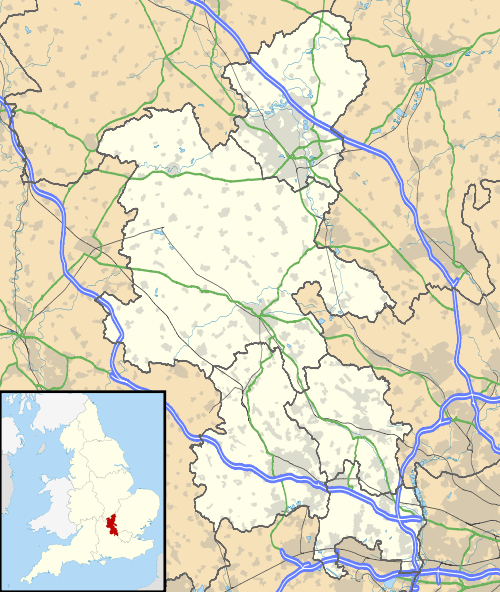Cowleaze Wood
Coordinates: 51°39′18″N 0°56′42″W / 51.655°N 0.945°W
| Cowleaze Wood | |
|---|---|
|
Bluebells in Cowleaze Wood | |
 Cowleaze Wood | |
| OS grid reference | SU726957 |
Cowleaze Wood is a 70-acre[1] area of woodland in the Chiltern Hills of England, situated on the Oxfordshire/Buckinghamshire border about 3 miles west of the village of Stokenchurch. The wood is currently owned by the Forestry Commission, who planted it between 1957 and 1966.[1] It is particularly known for its bluebells,[2] and walkers are also attracted to the wood by sightings of red kites.[3][4] There is a large car park adjoining the wood, and a picnic area with sculptured benches designed by furniture designer Fred Baier.[5]
On 31 March 1944, an RAF Halifax bomber crashed in the area of the wood when returning from a bombing raid on the German city of Nuremberg. The entire seven-man crew was killed in the crash, which is commemorated with a small memorial.[6]
Sculpture trail

For 17 years, Cowleaze Wood was home to the Chiltern Sculpture Trail. The trail was created in May 1990,[1] as a joint initiative between the Chiltern Sculpture Trust and the Forestry Commission,[2] who had been placing sculpture in woodlands under their management since the 1970s.[7] The 2-mile trail featured the work of a range of artists working with different media, with pieces being commissioned and produced specifically for the woodland setting.[8][9] Many of the pieces were hidden and blended with the landscape. Richard Mabey, writing in the Independent on Sunday, commented: "All along the trail, serendipitously windthrown logs, dens, a polythene bag wrapped round a branch in the shape of a squirrel, make you wonder whether you are looking at a deliberate work or a natural happening."[7] Sculptures that appeared as part of the trail included a giant picnic table by Robert Jakes and a metal "fish tree" by Paul Amey.[7]
The sculpture trail was open to the public all year round at no charge. The chairman of the Sculpture Trust estimated in 2007 that the trail had received in the region of 80,000 visitors a year. It was closed in 2007 owing to a lack of funding; the maintenance costs were around £25,000 a year. At the point of closure, there were 20 sculptures in the wood, some of which were sold at auction.[9]
Bald Hill
Within the wood is Bald Hill, the highest point of the historic county of Oxfordshire at 257m. It remained the high point of the County until 1974, when boundary changes meant that it was demoted by Whitehorse Hill which is slightly higher at 261m and the current County top. The historic high point is located at SU72889577, but is unmarked and difficult to find with any certainty. The location is of interest to participants in Hill bagging who visit these high points of the historic counties of England.[10][11]

| Wikimedia Commons has media related to Cowleaze Wood. |
References
- ↑ 1.0 1.1 1.2 Binns, Richard (13 January 1991). "The Missing Link – M40". The Sunday Times.
- ↑ 2.0 2.1 "Cowleaze". Forestry Commission. Archived from the original on 28 April 2012.
- ↑ John Cleare (1 May 2011). The Ridgeway. frances lincoln ltd. p. 42. ISBN 978-0-7112-3035-4. Retrieved 28 April 2012.
- ↑ "Red kite captures windfall". This is Oxfordshire. 7 November 2000.
- ↑ "Cowleaze – Car park". Forestry Commission. Archived from the original on 28 April 2012.
- ↑ "Cowleaze Wood". The Chilterns AONB. Chilterns Conservation Board. Archived from the original on 28 April 2012.
- ↑ 7.0 7.1 7.2 Mabey, Richard (25 June 1995). "Country life". The Independent on Sunday.
- ↑ Dymond, Christian (26 April 1997). "Carving through the forest". The Times.
- ↑ 9.0 9.1 "Chiltern sculpture trail to close". Oxford Times. 27 November 2007.
- ↑ Muir, Jonny (2011). The UK's County Tops: Reaching the top of 91 historic counties. Cicerone. p. 42. ISBN 9781849655538.
- ↑ Simon Edwardes (2001). "Bald Hill". The Mountains of England and Wales. Retrieved 20 May 2014.
